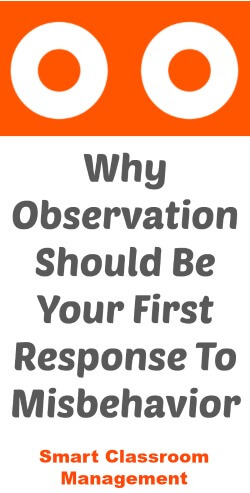
Yelling from across the room, waving to catch an offending student’s attention, rushing into a disruptive scene with flashing eyes and rising temper . . .
These are natural, instinctual reactions.
As caring teachers, we’re wired to fix problems and put out fires as fast as we’re able.
But the truth is, you’re far better off allowing misbehavior to play out.
You’re better off taking your time, moving into position, and observing it closely, discerningly, and in its full glory.
You’re better off responding only when the incident is over.
Here’s why:
It minimizes the disruption.
Getting involved too quickly has a way of agitating students, often inciting an immediate, argumentative, and angry defense.
It increases the level of tension in your classroom, extends and intensifies the disruption, and forces you to make decisions before having a chance to fully understand what happened.
Merely observing from a safe but noticeable distance, on the other hand, has a calming effect on students, remarkably so, and gives you a better understanding of the facts before responding.
It provides a model for your students.
Keeping your cool keeps your students cool and provides a model for how to behave when things don’t go their way, when the inevitable stresses in life come upon them.
It shows them how to handle disagreements, disruptions, and disappointments with patience and composure. It teaches them to face their challenges head-on, but under control.
It gives your students an opportunity to rethink their behavior.
When misbehaving students feel your heavy gaze upon them, when they know that you’re recording their every move, they’ll naturally, almost magically, take a moment’s pause.
And it’s in this brief window of time when second thoughts are considered, when mistakes are acknowledged, when apologies are offered, and when lessons are learned.
It allows you to follow through without drama.
One of the great benefits of observing first is that your students will be less likely to argue with you or lie about their involvement.
Because you’ve given yourself the opportunity to witness firsthand their misbehavior, and because your students know this is the case, you can follow your classroom management plan with little if any complaint or protestation.
It gives you the efficient power of the truth.
When you’re a primary witness to misbehavior, you don’t have to waste time pulling students aside. You don’t have to put your classroom, your lessons, or your pleasant mood on hold to get to the bottom of it.
You don’t have to slog your way to the truth. Knowing the truth through observation allows you to hold students accountable quickly, so you can get back to teaching.
Your Observing Presence Is A Powerful Deterrent
It’s very uncomfortable, awkward even, for misbehaving students to be under the watching eye of a truth-seeking teacher.
Even the most challenging students are affected.
You can see it in their face and feel it in the air as you watch them reconsider their behavior choices. They may glance over at you—and continue to glance over at you as they try to make sense of their actions.
It’s always smart to pause a bit even after the misbehavior has stopped. Let the awkwardness, the ‘I know that you know that I know’ moment to hang in the air before opening your mouth.
Often, the look your students will give you will be the same look teachers work so hard for, but rarely get.
They lecture, question, and admonish. They browbeat and scold. They go around and around. They all but pull their hair out just to see some recognition of responsibility.
But when that look of ownership comes of the student’s own volition, and without your prompting, it is so, so powerful. It dissuades future misbehavior. It encourages self-reflection and a private vow to improve.
It sparks empathy toward those they have disagreement with.
Lessons learned on their own, you see, are lessons that resonate deep in their heart, where lasting change happens.
If you haven’t done so already, please join us. It’s free! Click here and begin receiving classroom management articles like this one in your email box every week.

Is there a level at which you should intervene or does all misbehavior fall under this category? I ask because I had one student push another and they were about to get into a physical altercation. I stopped them before it escalated. I thought that was what I was supposed to do. Would it instead be better if I removed my other students from the altercation and allowed it to play out? I apologize if this seems like an obvious question, but I want to be able to understand how to deal with extreme behaviors effectively.
Hi Cam,
No, you certainly don’t want misbehavior to play out if your students are in any danger.
Michael
I am a veteran teacher who has moved into a new area, Alternative Learning Education, grades 7-12. Right now, I only have 4 students however the classroom can grow to as many as 15.
Do you have suggestions on how to enhance these strategies with students in Alternative Learning environments?
Hi Melba,
No, I think they’re maximally effective as is.
Michael